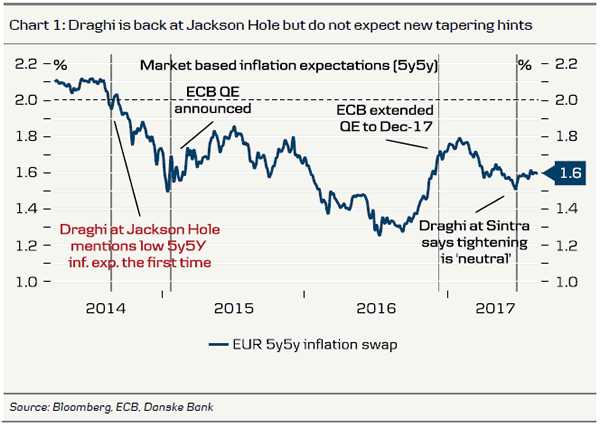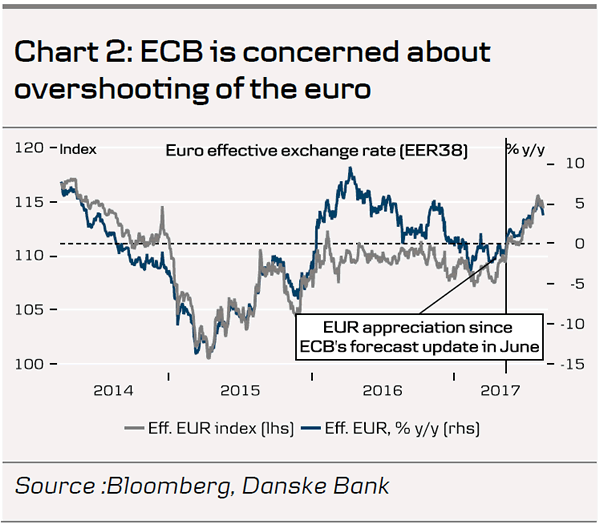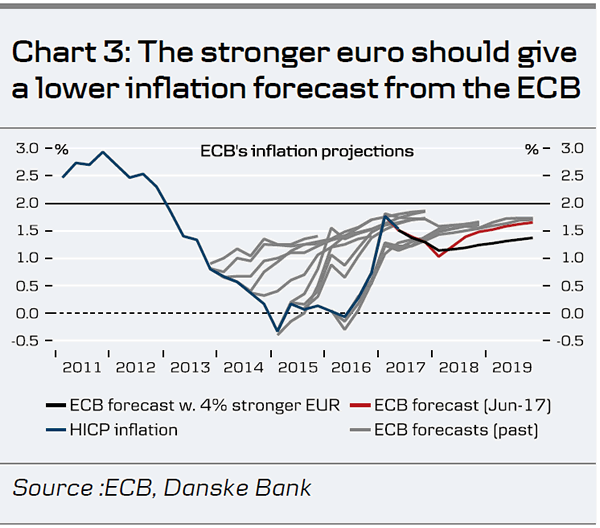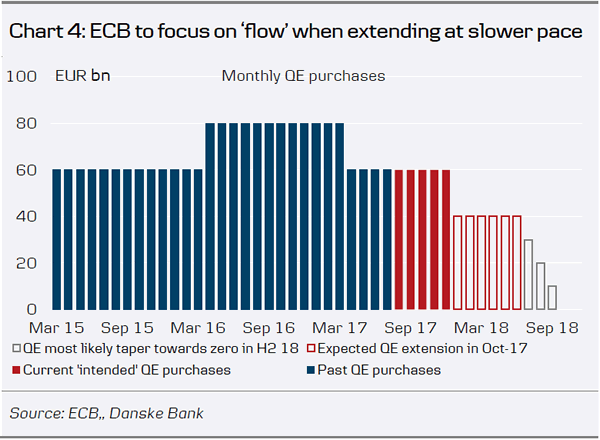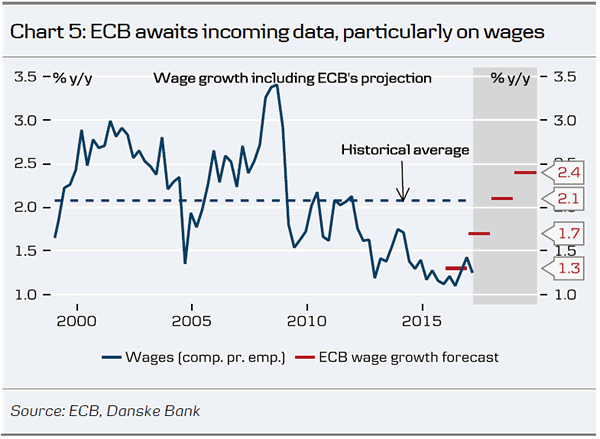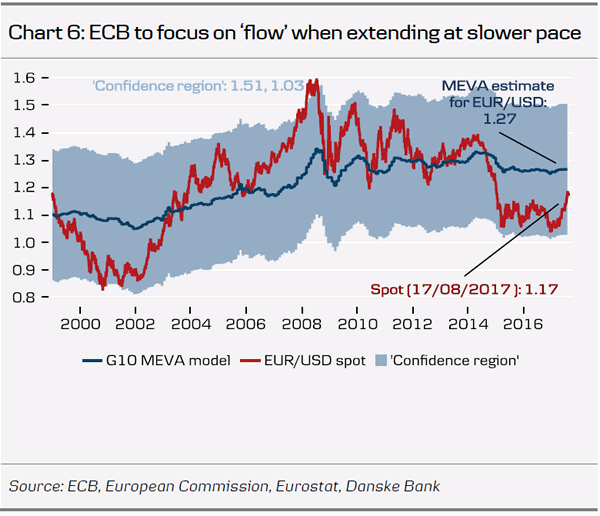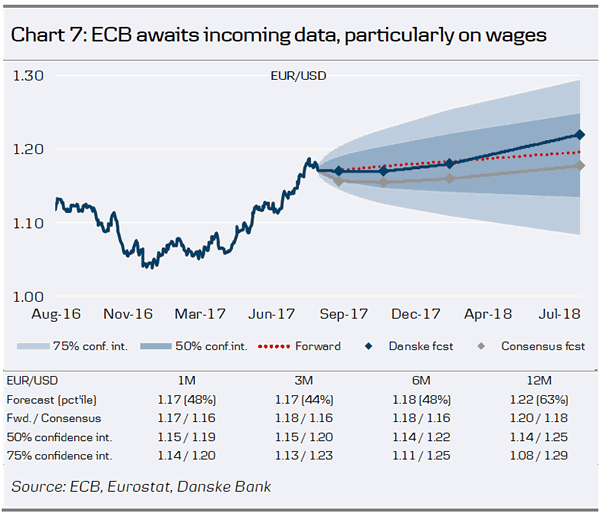Key points
- ECB president Draghi is returning from summer holidays and will speak at Jackson Hole for the first time since his ‘QE hint’ in 2014
- We expect a continued dovish stance from Draghi as the euro appreciation will dominate factors suggesting a more hawkish stance
- The ECB minutes revealed concerns about the euro overshooting which once again suggests the ECB’s exit will be very gradual
- We expect the ECB to focus on the stock instead of the flow argument when revealing its QE strategy for 2018
The ECB president Mario Draghi is returning from summer holidays next week and all eyes will be on his communication following strong economic data but also a significant euro appreciation. Draghi is scheduled to give a keynote speech in Germany on Wednesday followed by his participation at the US Jackson Hole Symposium on 24-26 August. Market participants have speculated on Draghi seizing the opportunity to hint at QE tapering at Jackson Hole, which would be very symbolic following his indirect QE announcement at the symposium three years ago.
The speculation about Draghi signalling some kind of QE tapering at Jackson Hole was sparked after his hawkish twist at the ECB Forum on Central Banking in Sintra in June. Since then, a number of factors have supported the case for a hawkish view. First, the deflation risk has abated further while the stronger growth momentum – which Draghi was very focused on at Sintra – has continued. Second, the ECB’s purchase pattern still suggests the QE restrictions are binding, implying the ECB could be looking for some sort of excuse to taper the purchases as the pressure for changing the restrictions again is likely to be muted given the above. Finally, Draghi will be among global central bank colleagues, which has on previous occasions resulted in him expressing a more hawkish stance as also seen at the ECB Forum in Sintra.
On the other hand, there are arguments for a continued dovish stance and in our view, they will dominate, implying Draghi will not send a new signal about QE tapering. The main argument why Draghi will not turn hawkish and signal QE tapering is that this could fuel the euro appreciation, thereby putting downward pressure on the outlook for growth and inflation, see Euro Area Research: Stronger EUR keeping inflation far from the ECB’s target, 27 July 2017. This is in line with the communication in the ECB minutes from the meeting in July where ‘concerns were expressed about a possible overshooting in the repricing by financial markets, notably the foreign exchange market’ and that ‘favourable financing conditions could not be taken for granted’.
Another argument for a continued dovish stance from Draghi is that any hints about the future of QE next week will be against the latest communication that this will be considered ‘in the autumn’, hence it could spark renewed criticism of Draghi’s leadership style. Following Draghi’s hint at QE at the Jackson Hole symposium in 2014, some Governing Council members criticised Draghi for erratic communication and urged him to act more collegially, see Reuters, 4 November 2014. Since then, Draghi’s communication has been more cautious and we do not expect him to deviate from the communication at the ECB meeting in July where he said regarding the QE programme ‘our discussion should take place in the autumn’.
Additionally, according to Reuters, sources familiar with the situation said this week that Draghi will not deliver a new policy message at Jackson Hole. According to the sources he will instead focus on the symposium theme ‘fostering a dynamic global economy’. Moreover, the sources said that October is the most likely date for the most substantial decision given the incoming data schedule, particularly on wages (see chart 5), see Reuters, 16 August 2017. This is in line with our view that the ECB will announce a QE extension at the October meeting with some signalling of it in September.
A continued dovish stance will again be consistent with the ECB minutes from July which once again suggested the ECB’s exit from its extraordinary monetary policy will be very gradual. As an example of this, the ECB decided in July not to give an incremental adjustment in the forward guidance as ‘it was generally judged paramount at this stage to avoid sending signals that could be prone to over-interpretation and might prove premature’.
In addition, the minutes turned attention to the total stock of the QE programme versus the monthly flow effects of the QE purchases. When the ECB reveals its strategy for QE purchases beyond the currently communicated horizon we believe it will argue that it is adding more easing (higher stock), although we look for a slower pace of monthly purchases of EUR40bn (lower flow). Hence, we expect the ECB’s communication to be anchored around the stock consideration in line with the announcement in December 2016, when the ECB extended QE by nine months but continued at a monthly pace of EUR60bn down from EUR80bn (see Chart 4). Furthermore, the ECB is likely to embrace the flow effect from the reinvestments when (as we expect) it reduces the monthly purchases.
Fixed income: a dovish message supportive for periphery bonds
If we see a dovish message from Draghi it should be supportive for European fixed income. Periphery bond markets in particular should benefit, as the risk of the PSPP purchases being tapered aggressively should be lower. We continue to favour the carry seen in the Italian and Spanish curves and to see the 5Y points as the ‘sweet-spot’. But Bunds should also see support from a dovish Draghi, and a further Bund-spread widening should be expected. The lack of Bunds will increasingly be a market theme. The fixed-income market will also scrutinise any possible comments on how to reinvest in 2018.
FX: rangebound now – but more ‘central-bank exit pricing’ later
What does it mean for the FX market that the ECB (and other central bankers) are now starting to retreat a bit from the early-summer hawkishness. Looking back, central-bank communication during the month of June – topped by messages at the Sintra conference late in the month – turned notably more hawkish which we interpreted as a growing acceptance of USD weakness ahead, see e.g. FX Forecast Update: A Sintra accord? 14 July 2017. But since early August this has reversed somewhat with first the BoE keeping a dovish tone in August, then the Fed voicing very explicit concerns over inflation, and most recently the ECB sounding rather concerned regarding the risk of the euro rising too much too fast. Thus, it is back to trial-and-error mode – notably with respect to how communication affects currencies – for central banks in how they signal around their exit strategies – and this is set to continue well into a ‘policy normalisation’ process. In our view, for the near term this means both EUR/USD and EUR/GBP will stay within the recently established (higher) ranges, and we still see the former rangebound between 1.15 and 1.20 in 1-3M and EUR/GBP in the 0.90-0.92 interval near term. In the Scandi sphere, the situation is slightly different with notably the Riksbank looking into (temporarily) higher inflation prints; that said, we deem it is still too early for the FX market to price Scandi strength on a wider scale. In this week’s FX Forecast Update: Taking a breather before next leg of ‘central-bank exit pricing’, 16 August 2017, we stress that we see ranges in many currency pairs near term but that the next leg of central-bank (ECB in particular) exit pricing will materialise later this year – and that EUR/USD in particular is headed for a firm move above 1.20 into 2018.
